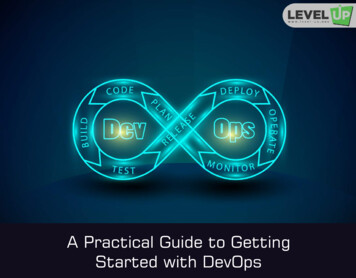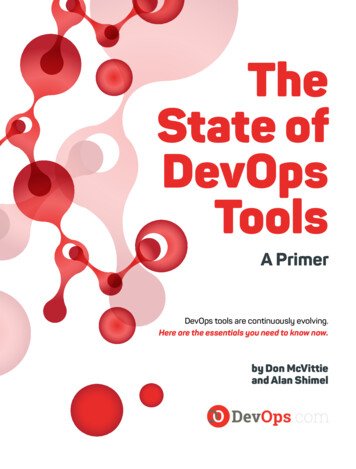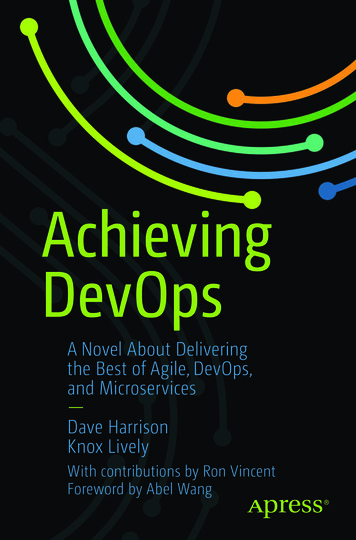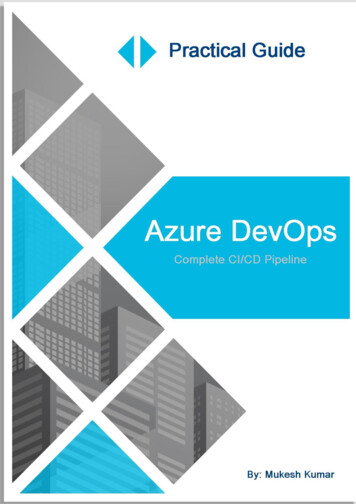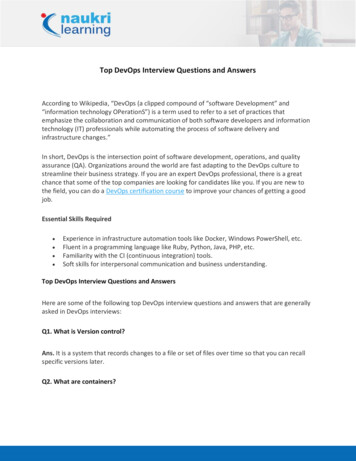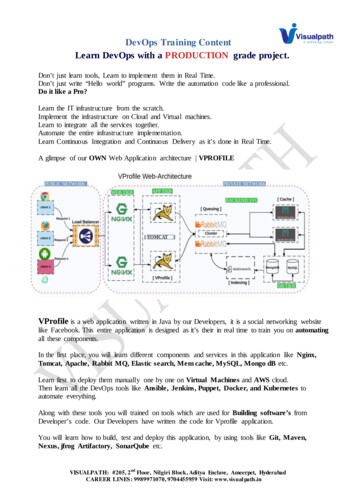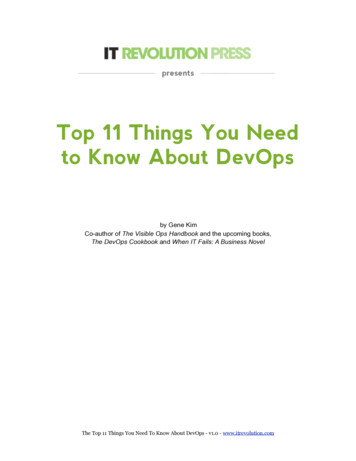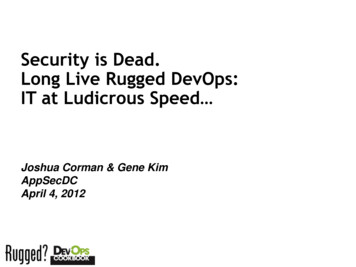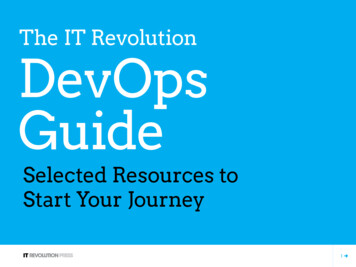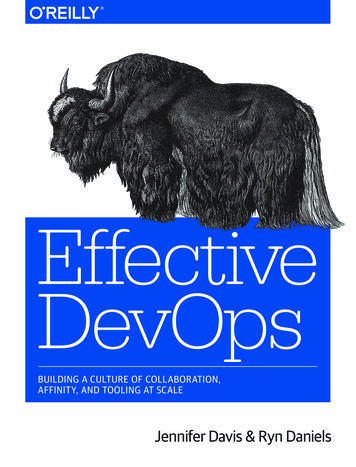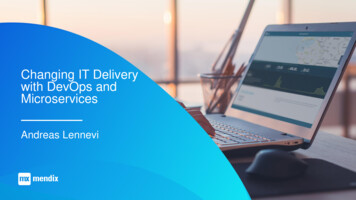
Transcription
Changing IT Deliverywith DevOps andMicroservicesAndreas Lennevi
“Enterprise DevOps”Forrester in Oct 2017 predicted: “2018 will be The Year Of Enterprise DevOps” More than 50% of organizations are implementing DevOps Discussion shifted from: “What is DevOps?” to “How do I implement DevOps at scale?”. DevOps momentum is occurring in all industry sectors. Although many organizations are in the experimentation stage with singleor multiple pilots – they all are transitioning toward DevOps acrosstheir entire enterprise.
Trends merging into coherent Movement:SOAMicroservicesAgile TeamsMode 2, DevOps& Agile MindsetMicroservicesEnterprise DevOpsCI/CDDevOps AutomationCloudContinuous IntegrationRelease AutomationInfra Automation201020152020Smaller ScaleLess Central ITAutonomous TeamsAutonomous ComponentsBusiness & IT AlignmentSpecialization for PurposeHigh Productivity ToolingAutomate EverythingMeasure EverythingDevelop TestabilityDevelop OperabilityLocal Ownership
Enterprise DevOpsWhy? Faster Product Delivery Manage Shifting Priorities More Value / Worked HourAgile onCorporate LevelLocalize Biz-ITInvestment, lessannual budgetsIntegrate Dev,Ops, Test and BizMake IT &Business worktogetherDecentralizeDecision Making
Agile Development Rigid Ops Rigid ITBizDevOpsDevelopment becameAgile and EfficientOperations stayed rigidand stability focusedAgileBusinessNon Agile when in OpsDevelopmentOperations6 Weeks to Build6 Months to Go-Live6 Seconds to Imagine6 Hours to Define
DevOps – The CultureWrecking -not-a-role-comic
DevOps PillarsAgile all the way fromBusiness to Ops“CAMS”Automate to avoid Ops workUse similar tools and methodsin Dev and OpsDevOps Collaboration& Automation forBiz Dev OpsShare problems andsolutions from Biz toDev to Ops and back“CAMS” by John Willis: John Willis coining “CAMS”:Monitor Use & Performance,Predict issues in PRDMeasure Value & FeedbackNew IT4IT type tools8
BusinessBIZ .Conflicting Objectives of DepartmentsGet NewFunctionsMaintain StableEnvironmentsBring NewFeatures LiveAvoidRiskTSTCultureclashDEVOPS
BizDevOps: Cooperating around Joint ObjectivesGet NewFunctionsBusiness UnitDEVOPSMaintain StableEnvironmentsTESTAvoid RiskAvoidRiskMaintain StableEnvironmentsCommonObjectivesDevPutting people in the same team, makes themsee the same problems and solve them togetherDEVTestOPSTESTBring NewFeatures LiveGet NewFunctionsBring FeaturesLiveUSETimeUSEBusinessUnitProductOpsAfter some time with joint Objectives,priorities align & team works as a unit
BizDevOps: Small Team Owns entire Life CycleBizDevOps Teams with Agile MindsetContinuous DeliveryContinuous ReleaseApplicationUsage
Why is DevOps so Appealing:Business & IT iteBusiness & IT AlignmentWith flexibility and lower cost changesInnovation & Efficiency(Biz)DevOpsBusiness focused Teamswith ownership(Biz)MicroservicesArchitecture aligns withBusiness FunctionIT Delivery AutomationCloud, CI/CD, hpaPaaS, RAD, Ops tooling
Business – IT Alignes by Maximum OwnershipBy ownership and independence we get flexibility and innovationBusiness LineDevOps teamMicroserviceDevOps reDevOps teamMicroserviceBiz-IT teamsLarger Business unitBusiness unitMicroserviceAlignmentviaOwnershipBusiness unitMicroserviceBusiness lineMSA SystemOrganization, Process, IT Teams & IT Components are not independent from each other.Rather the opposite. This means the Business has a strong stake into Architecture.
Microservices For AlignmentComponents of the Future will be more Business Like:“Microservices interact as Actors in a Business process”Maximize Probabilitythat a new Featurerequest lands in onesingle Microservice?Owned by oneBizDevOps AccountsInvoicingRef: O’Riley, Sam Newman
Final Stage DevOps (Team has beeper for alarms):“Ops work keeps adding up for team with many Apps”FeatureDevAvailableRisk that Innovation mindeddevelopers get bored?Capacity of DevOps Team 1Smaller and smaller capacityfor new feature development AutomateThis is the valuedrivers of DevOpsInnovate &Create ValueOps work App 1TimeApp 1App 2App 3App 4App 5
Final Stage DevOps (Team has beeper for alarms):“Ops work keeps adding up for team with many Apps”FeatureDevAvailableTeam is “Digitizing” its ownprocessesCapacity of DevOps Team 1Increased Automation improvesstability and frees up capacityOps work App 1App 1App 2App 3App 4App 5Time
People often take 2-3 Roles in BizDevOpsBizDevOps Team – of 4-10 PeoplePO, BA, Biz SME, Test, Data Admin, SupportSA, Process, Agile Coach, Lead Dev, TestDevTestOpsTestOpsDeploy
Origins and Evolution of DevOps DevOps starts from a Developer’s revolt against Agile Too much process, no real ownership, not Agile on business level The rest of the organization is not aligned with agile BizDevOps now Expands Agile to Business, Management andOperations It addresses some weaknesses with a central IT department But this requires Changes in HR, Teams and Organization Enterprise DevOps now driven from CIO/CEO level Perfectly suited for building Microservices and using Mendix
DevOps Focus AreasMode 2, Release InnovationAutomate and MeasureProductDevTestOpsMode 2 with Agile MindsetStart with DevOps for Mode 2Evolve into larger ScopeRAD & MicroservicesTooling & Automation:CICD – Auto-testing - MonitoringCloud – IT Tooling – Value MeasureArchitecture:Move away from SOA and MonolithsCorporate Change ProgramFull Organizational ChangeJoin al Teams & Priorities, use IT4ITDevOps, Microservices and CICD
How does this transition happen?And How do I make it BizDevOps?IT DevelopmentDepartment800 PeopleIT Operations200 PeopleBusiness Units10 000 evOpsDevOpsDevOpsDevOpsDevOpsDevOpsOpsOpsOpsOps 100 DevOps Teams
How does IT4IT compare with DevOps?More CentralControl &Standardization20% of developersbecome even morehard-core techie?80% become morebusiness oriented?LeanCultureStandard Framework & Automation Tools Can enable DevOps teams to work inthe Business Domains again improved Business & IT aligmentMore AutomationLocal Control &DecentralizedDecision MakingBizDevOps
Enterprise DevOps in Large Scale – Challenge:IT DevelopmentDepartment800 PeopleEnterpriseDevOpsIT Operations200 vOpsDevOpsDevOpsDevOpsDevOpsDevOpsOpsOpsOpsOpsWe need to avoid ChaosWe need some standardsAnd some common components 100 DevOps Teams
Likely Evolution: Maximize Autonomy of Biz UnitsCorporate Biz ManagementBusDomainBusDomainBusDomainCorporate ManagementWith lead CIOBusDomainBusDomainBusDomainCentral IT, Mgr CIODevOpsCentral ITDoing mostly IT DevOpsCentralize IT 2005DevOps in IT Department 2015Decreasing complexity of IT?Corporate ManagementWith CIO & OpsBizDevOpsBizDevOps Full Org by 2025
Levels for DevOps StructuresEnterprisePlatform, Infrastructure, ToolingPortfolio, Road-map, Business CaseGovernance, Review & AssistanceEnableProgramLarge Programs, Clear ObjectivesOperational ImprovementsLegacy MigrationDeliverInnovateSmaller projects, Discovery Mode, Very AgileInnovation, Design Thinking, UX focusClose co-opration with the BusinessDiscover
Business Domains, Delegation and what’s left of OpsUSEUSEUSEDEVUSEOPSTribeOPSTESTTESTDEVBusiness UnitDomains withdelegatedresponsibilityhaving TribesSpecialized atsupporting aspecificDomainBusiness UnitCross polinate ideas & increasecooperation between tribesOps / IT4IT / Central ITOpsManagementCommon Automation andIT Management ToolsOPSBusiness UnitBusiness UnitUSEBusiness UnitDEVDEVOPSTESTTESTUSEOPSTESTDEVOPSBusiness UnitBusiness UnitBusiness UnitTribeDEVOPSTESTDEVTESTOPSTESTDEVBusiness Domain 2USEUSEBusiness Domain 1IT4IT Tools,CICD etc.ChangeAngelsHelpdesk/Call CenterExpertResourcePoolManage fluctuatingresource needs
Governance: Enterprise – Programs – TeamsFOCUS LEADERS Mx Platform Owner Enterprise Architect AEnterpriseboardFunding & Strategic returnProgram alignmentPortfolio and RoadmapTransformation riskPlatform & Common ComponentsGuidelines and Epic level ReviewFOCUSLEADERS Program owner Solution Architect Scrum Master APROGRAM LIFECYCLEProgram1Program2LEADERS Product owners Lead Developer PRODUCT LIFECYCLETeamATeamBTeamCBusiness SponsorshipTeamD Resources & PlanningGuide, Assist, ReviewCoordinate & CommunicateROIFOCUSScopeTimeCostQualityA
Full SAFe
Microservices Andreas Architect
29Definition of Micro Services(James Lewis & Martin Fowler)“The Microservice architecture style provides an approach to: Build larger applications as a suite of smaller services ( ITcomponents or Apps), where each service: Is built around a business capability, Runs its own process, Communicate via a light weight mechanism, And is independently deployable by an automated roservices/#what
30Definition means (James Lewis & Martin Fowler)We split a largesystem in smallerindependent piecesthat work togetherMSALarge SystemSystemWe call that aMicroserviceArchitecture System
31Definition means (James Lewis & Martin Fowler)With autonomousservices that all fill abusiness purposeCommunicating viaservices or deep-links
Overview ComparisonTraditional SystemOne large System withinternal ModulesSOA “System”Microservices SystemIndependent SpecificComponentsShared LayeredComponentsUI LayerMicroserviceGUIMicroserviceLogic LayerProcess LayerlogicMonolithSystemprocessdatabaseMonolith rviceMicroserviceFederated ApplicationData LayerdatabaseBack-endSystemLayered Application
There is More to Microservices than Size !SOA and MonolithsMicroservices“Share as much as Possible”“Share as little as Possible”“Do not Copy Data or Functions”“Copy what I need to do my Job”“Align teams with Technology”“Cross functional Teams”“Own a layer”“Own a business function”“Business alignment starts by understanding each other, and ends with working together”33
Why Microservices? Because Size argeScopeUser-groups1.2.3.4.5.Too many user groupsToo many developersToo many dependenciesSlow App generationLack of exibilityUnacceptable speed
Real-life “Autonomous Units” Knowledge is better copied betweenindividuals Merged with the experience andneeds of each students Creates new valuable combinationsof information and function
Years of Architecture habits to Un-learn“We have been learning to maximize re-use and minimize duplication.”What is the cost of sharinga component?
The Microservice key word is AutonomyBuilding complete Business Functions as MicroservicesCopy only the functions and data we really need to work properlySome times for very stable functions to re-use as a service
Autonomous Microservices for Core copeCore BusinessSystem1 SystemArchitectBusinessOwners1 System ProcessArchitect Architect
No Silver Bullet anymore – and not One OptionSplitting in smaller pieces has a cost The Reason is often Functional and orBusiness oriented, so I need help.so I should only Split things when Iam sure I know the right reason to splitConsidering more than one option is anecessity to weigh pros and consAutonomySystemArchitectProcessIndependent Phasesof DevOps teams and Business UnitsDevOps team managesOperabilityIn DevOps Culture decisions aretaken as a Team
Process & Business Flexibility in the CentreProcess ArchitectsBusiness & IT AlignmentMicroservicesArchitectureBusiness OwnersDevOps EfficiencyDigital EvolutionDevOps team managesOperabilitySolution Architects
Microservices Thinking is Good for Mendix Microservices is 100% in line with the DevOps trend Microservices has become ‘the new thing’ after SOA Mendix makes Microservices by Default
Business Features usually have Data, Logic & UI Mendix makes Microservices by DefaultOne DeployableOne ModelGUI neededBusinessFeatureRequirementLogic neededData neededAppSome level of “IntegrationTest” and CICD whenchecking into team-server
Mendix Platform – Pre-built AutomationMendix Style Microservice SystemMicroserviceMicroserviceMicroservice5-10 uyAutomationJava Style Microservice nDBMSMSMSMSMSMSDBHarder toalign IT withBusinessPeople
Mendix for Core SystemsAdaptive Governance per System Type:X 10System of Innovation(life-span 1-5 years)Maximum Speed of DevelopmentMinimal amount of GovernanceFix things after peer ReviewMove fastChange laterX7System of Differentiation(life-span 3-10 years)Start with Architecture WorkshopMaintain good SpeedEstablish reasonable GovernanceThink FirstFocus on QualityX3Core System(life-span 5-30 years)Full Analysis phase in the beginningFull Governance, Testing & DocumentationDisaster Recovery proceduresAnalysis requiredConstant reviewAdditional testing44
Business Features usually have Data, Logic & UI Mendix makes Microservices by DefaultOne DeployableOne ModelGUI neededBusinessFeatureRequirementLogic neededData neededAppSome level of “IntegrationTest” and CICD whenchecking into team-server
The Business & IT Alignment ExplainedBusiness is involvedin IT delivery.DevOps teams staywith business units.Business & IT AlignmentOwnership &Autonomy(Biz)DevOpsSmall team handlesfull life-cycle(Biz)MicroservicesLess technical teamsIT Delivery Automation, Cloud, CI/CD, aPaaSConways law:Align componentswith organizationAutomationreduces cost ofhaving smallercomponents
Business & IT AlignmentDevOpsMicroservicesIT Delivery AutomationBusiness & IT AlignmentDevOpsMicroservicesIT Delivery AutomationBusiness & IT AlignmentDevOpsMicroservicesIT Delivery AutomationBusiness & IT AlignmentDevOpsMicroservicesIT Delivery Automation
Questions?AndreasArchitect
Mode 2, DevOps & Agile Mindset Microservices 2015 Enterprise DevOps Microservices CI/CD DevOps Automation 2020 Smaller Scale Less Central IT Autonomous Teams Autonomous Components Business & IT Alignment Specialization for Purpose High Productivity Tooling Automate Everything Measure Eve

